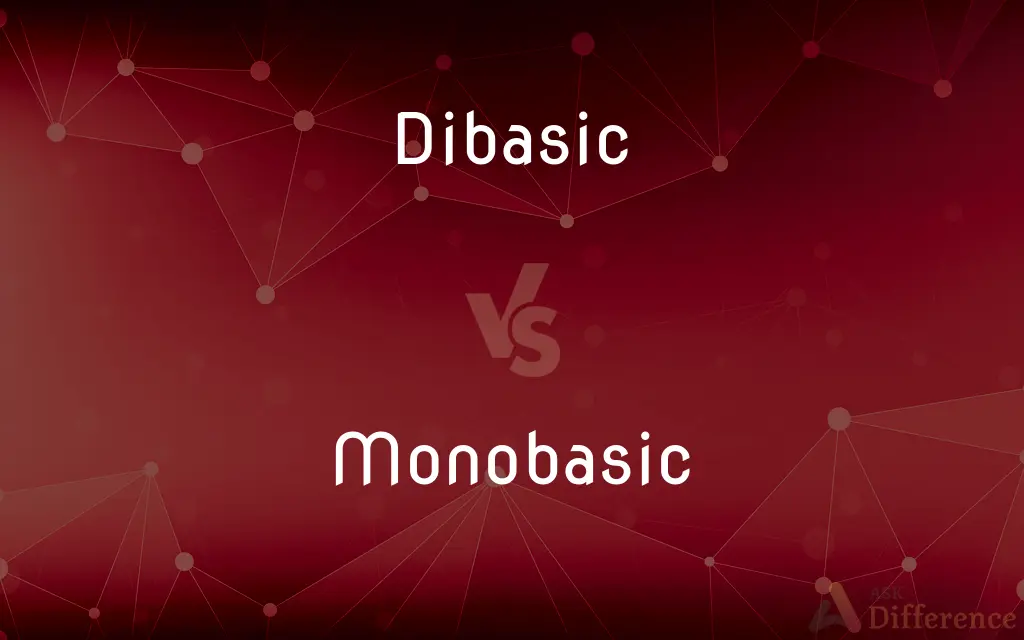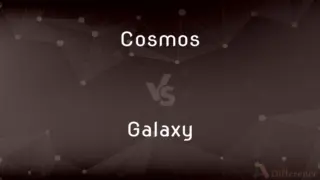Dibasic vs. Monobasic — What's the Difference?
By Urooj Arif & Maham Liaqat — Updated on April 23, 2024
Dibasic refers to a compound with two hydrogen ions available for replacement in an acid-base reaction, while monobasic denotes a compound with only one replaceable hydrogen ion.

Difference Between Dibasic and Monobasic
Table of Contents
ADVERTISEMENT
Key Differences
Dibasic compounds, such as dibasic acids, have two hydrogen ions (H+) that can be replaced or donated in reactions, making them capable of forming two sets of salts. This characteristic is essential in various chemical and biological processes, where the compound's ability to donate two protons plays a critical role in reactions. Monobasic compounds, on the other hand, contain only one hydrogen ion available for replacement, limiting them to forming a single set of salts. This fundamental difference affects how these compounds participate in chemical reactions, their reactivity, and their applications in industry and research.
In terms of acidity, dibasic compounds can exhibit varying levels of acidity depending on which hydrogen ion is being donated, as the two hydrogen ions may have different affinities for donation. Monobasic compounds have a more straightforward behavior since they can donate only one hydrogen ion. The pH levels they can achieve in solutions and their role in buffer solutions vary accordingly, with dibasic compounds often playing a more versatile role in maintaining pH stability in biological and chemical systems.
Dibasic and monobasic compounds are also crucial in the formulation of fertilizers, pharmaceuticals, and various industrial chemicals, where the specific needs for acidity or reactivity determine the choice between dibasic and monobasic compounds. For example, monobasic phosphates are often used in liquid fertilizers due to their solubility, while dibasic compounds find applications in more controlled-release formulations.
The solubility and reactivity of these compounds differ significantly, impacting their use in chemical synthesis and manufacturing. Dibasic compounds, offering two points of chemical interaction, can engage in more complex formation reactions than monobasic compounds, leading to a wide range of chemical behaviors and applications.
While both dibasic and monobasic compounds play vital roles in chemistry and various applications, their differences in hydrogen ion availability, acidity, reactivity, and applications highlight the importance of understanding chemical properties for specific uses.
ADVERTISEMENT
Comparison Chart
Hydrogen Ions
Two replaceable hydrogen ions.
One replaceable hydrogen ion.
Salts Formed
Capable of forming two sets of salts.
Capable of forming one set of salts.
Acidity Levels
Can exhibit varying acidity levels.
Typically has a straightforward acidity level.
Applications
Versatile in pH control, fertilizers, pharmaceuticals.
Often used in liquid fertilizers, specific pharmaceuticals.
Chemical Behavior
More complex interactions and reactions.
Simpler chemical reactions and interactions.
Compare with Definitions
Dibasic
Dibasic acids, like sulfuric acid (H2SO4), can donate two protons in reactions.
Sulfuric acid is used in industrial cleaning agents.
Monobasic
Monobasic acids, like hydrochloric acid (HCl), donate one proton.
Hydrochloric acid is used in pH adjustment and cleaning.
Dibasic
Dibasic compounds often participate in buffer solutions to stabilize pH.
Phosphate buffers in biological systems use dibasic phosphates.
Monobasic
Monobasic compounds are essential in liquid fertilizer solutions for immediate nutrient availability.
Potassium phosphate monobasic in foliar sprays.
Dibasic
Dibasic substances are used in controlled-release fertilizer formulations.
Dibasic potassium phosphate fertilizers for slow nutrient release.
Monobasic
They form single salts, simplifying reactions in manufacturing.
Potassium chloride (KCl) from hydrochloric acid.
Dibasic
The versatility of dibasic compounds extends to pharmaceuticals, offering varied medicinal properties.
Calcium phosphate dibasic in supplements.
Monobasic
In pharmaceuticals, monobasic compounds are used for their specific chemical properties.
Sodium phosphate monobasic as a laxative.
Dibasic
They can form secondary salts upon partial neutralization.
The formation of sodium hydrogen sulfate (NaHSO4) from sulfuric acid.
Monobasic
Their reactivity is crucial in synthesizing various chemical products.
Monobasic acids in organic synthesis and polymer production.
Dibasic
Of or relating to salts or acids forming salts with two atoms of a univalent metal. Na2HPO4 is an example of a dibasic salt.
Monobasic
Of or relating to salts or acids forming salts with one ion of a univalent metal. NaH2PO4 is an example of a monobasic salt.
Dibasic
Diprotic.
Monobasic
Monoprotic.
Dibasic
(chemistry) (of an acid) containing two replaceable hydrogen atoms
Monobasic
Containing one replaceable hydrogen atom.
Dibasic
(chemistry) (of a salt) having two atoms of a univalent metal
Monobasic
Having one atom of a univalent metal.
Dibasic
Having two acid hydrogen atoms capable of replacement by basic atoms or radicals, in forming salts; bibasic; - said of acids, as oxalic or sulphuric acids. Cf. Diacid, Bibasic.
Monobasic
(zoology) Having only one subordinate taxon; monotypic.
Monobasic
Capable of being neutralized by a univalent base or basic radical; having but one acid hydrogen atom to be replaced; - said of acids; as, acetic, nitric, and hydrochloric acids are monobasic.
Common Curiosities
What defines a compound as dibasic or monobasic?
A compound's classification as dibasic or monobasic depends on the number of replaceable hydrogen ions it possesses: two for dibasic, one for monobasic.
How does the choice between dibasic and monobasic compounds impact fertilizer formulation?
The choice affects the release rate of nutrients; monobasic compounds are often used for immediate availability, while dibasic compounds can be formulated for controlled-release fertilizers.
Why are monobasic compounds preferred in some industrial applications?
Monobasic compounds are preferred for their straightforward reactivity and solubility, making them suitable for specific applications like liquid fertilizers and certain chemical syntheses.
Can a dibasic acid form both primary and secondary salts?
Yes, dibasic acids can form both primary and secondary salts, depending on the extent of their neutralization reaction.
What is the significance of secondary salts formation by dibasic compounds?
The formation of secondary salts allows for more diverse chemical reactions and applications, including specific types of fertilizers and chemical intermediates.
Why might a pharmaceutical formulation choose a dibasic over a monobasic compound?
The choice could be due to the specific absorption rates, chemical stability, or interaction with other components in the formulation, based on the desired therapeutic effect.
How do dibasic compounds contribute to controlled-release formulations in agriculture?
Their chemical structure allows for slower dissolution rates in soil, providing nutrients over an extended period and reducing the frequency of application.
How do dibasic compounds affect pH levels differently than monobasic compounds?
Dibasic compounds can offer more nuanced control over pH levels due to their ability to donate two protons, providing versatility in buffer solutions and pH adjustment.
What role do dibasic and monobasic phosphates play in biological systems?
They are critical in cellular functions and energy transfer, with their role in buffer systems being crucial for maintaining cellular pH levels.
Can the solubility of dibasic and monobasic compounds vary significantly?
Yes, solubility can vary based on the compound's structure and the presence of one or two replaceable hydrogen ions, affecting their use in various solutions and formulations.
Share Your Discovery

Previous Comparison
Cosmos vs. Galaxy
Next Comparison
Image vs. RepresentationAuthor Spotlight
Written by
Urooj ArifUrooj is a skilled content writer at Ask Difference, known for her exceptional ability to simplify complex topics into engaging and informative content. With a passion for research and a flair for clear, concise writing, she consistently delivers articles that resonate with our diverse audience.
Co-written by
Maham Liaqat












































